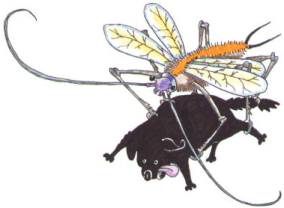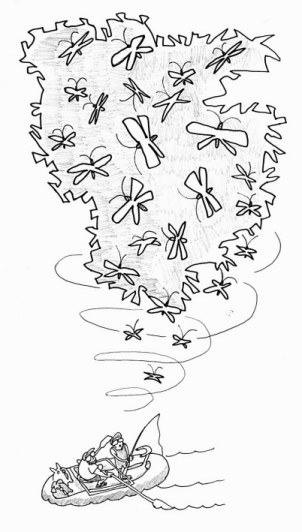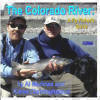Stonefly Fishing the Colorado River
Submitted by Michele White (Murray), Tumbling Trout Outfitters
(Ed. note - we left some of the images large so you can see the expression on the dogs' faces. Also, I missed this hatch by one week and am very jealous!)
Last Memorial Day weekend, we caught monster Rainbows on the Colorado River during an adult stonefly event -- not a hatch. It was a massive egg-laying carnival with clouds of adult stoneflies so thick in the air they blackened the sun. Dogs shivered. Hummingbirds tried to mate with them. Big ol' trout stared up at the sky 'til their necks were stiff. People with limp lines and stonefly nymph patterns asked us, "Hey, what're you using?" We pulled the prehistoric insects off our faces and said, "These".

I never saw anything like it before. They're large, creepy bugs with stickery little feet on long legs. Rafters examined the mysterious bugs, too. My sister, who didn't bring her glasses to the river, observed the throbbing orange stripe down their backs (she was poking a nicely painted fingernail at a stonefly that landed on her paddle in order to provoke it's orange signal).
Doug told me that the adult stoneflies don't come out very often, that mostly only the nymphs are active. Apparently, there is no pupa-emerger stage like we're familiar with caddis and mayflies. Some species of stonefly nymphs even live up to 3 years in the water. They eventually climb out of the river and cling to rocks. When they're good and dry they bust out of their shells and emerge as fully formed adults. Adult stonefly activity is rare, and certainly not something to rely upon. But, when the adults are active, the really big trout come up from their murky depths and feed exclusively on them, kind of like Free Hot Dog Day at the zoo. So, if you see adult stoneflies on the river, it's time to catch really large fish.
Shortly after we arrived at the confluence of the Colorado River and Sheephorn Creek near Radium, a large, grimy man came over with a 12-pack-size cooler and opened the lid to us without further explanation. In the cooler was a strange sight. The bottom was lined with half-eaten food in dirty Baggies, cigarettes, and a long twig with leaves. Against the sides were some dying adult stoneflies the size of hamsters. The most significant item was an enormous, 20"+ Rainbow trout fat as my leg, lying in a curl of rigormortis. It was the saddest cooler from Hell I'd ever seen a fish in … and a Rainbow at that! A fish like that could be The One that's resistant to Whirling Disease and even spawn a virus-resilient strain of Rainbows…
We thanked the guy and congratulated him for his fine catch. He left pleased with himself for either showing off his fish or for totally disgusting us. I'm not sure which effect he was seeking. Doug asked me, "Did you see what he had in there?" and I answered, "Yeah, a fish horror chamber", and Doug said, "Stonefly adults. Really big fish come up for those." Doug was unusually excited in his usually quite way. His eyes glowed.
We had trepidation about floating from Radium to Rancho because Hoyt's Rapids (Yarmony) are normally too formidable to take our dory down or risk the lives of our old dogs if they slipped in. That weekend we took our raft, instead, to buddy-spot through the rapids for my sister and her husband on their maiden voyage with their brand new raft full of friends.
We found a river-virgin (first-timer-to-rafting) to christen it with a Hamm's beer. She wasn't' the prettiest river-virgin we'd ever seen, (being a wee-bit older than color television and a little bit dour about getting wet), but she was the prettiest one standing on the bank in the drizzling rain. The river was actually really low, running at 500 c.f.s. River-virgin was even less enthusiastic when she realized she needed to wade halfway across the river and help drag the raft to the main current. We wrapped her up good in rain gear and tightened her life-vest extra snug to show our appreciation. Then, we all headed downstream, the rafters paddling against the wind.
Doug and I didn't fish. We could taste sour, unspoken tension on our tongues in anticipation of the upcoming rapids. We noodled apprehension between our fingers. We kept looking back at the raft full of loved ones behind us as they practiced maneuvers they would need to execute in the upcoming rapids. Their collaborated efforts resulted in slow spins and ass-backward assaults. I heard crabby little snippets of criticism flung at the captain, my brother-in-law, Ed. But they didn't look seriously mutinous. Then, I heard the growing thunder of Hoyt's coming from around the bend and Doug asked me, his voice all nervous, "Just stay left, right?" "Right, left." I answered.
I had dressed my sister in a neoprene dry-suit and everyone was wearing brand-new lifejackets and river-booties. Emergency gear and throw-lines were ready in case someone got sucked over-board by a big hole. Doug and I shot ahead and anchored off a rock to scout out the rapids on foot. We climbed high to overlook the slot at Hoyt's. Nothing there! The water was so low that we could have taken our dory through it. As the new raft entered Hoyt's, Doug popped open a beer. The crew paddled and the raft bumped into every rock through the channel. They looked around at us and spun slowly through Hoyt's, eventually exiting backwards from the chute.
 |
| Doug making sure rafters are ok. That is not a Pepsi he is holding! |
All fear gone now, we followed in our oar-framed raft. The only tricky part for an oar-framed boat is to find enough room in the water for the paddles to dig in between the rocks. A couple lateral moves were required to avoid going over big submerged rocks and small hydraulic holes. Doug executed the moves like a narwhale rider. None of the rocks rent our vinyl hull.
After Hoyt's, the fishing was very much ON! I looked up at the sky to welcome the sun and thank the River God for not swallowing my family. Then, I saw THEM for the first time - adult stoneflies in aerial ballet! They made a cloud like locusts and were high in the sky, not like caddis or mayflies. Stonefly adults fly way up where eagles and hawks go, like biplanes in combat. It was a cyclone of quad-winged bugs!
I loosened the sleeve of my rod casing and found that Doug had already rigged our rods for adult stoneflies before we left. First cast - BOOM! Big rainbow bent my little 7.5-foot #4-weight rod in half. Lost my hemostats but the hog-trout let himself loose anyway. Another cast - BOOM! Lost Doug's hemostats, too. After I caught about 10 rainbows over 20 inches, Doug and I traded positions - and we were only halfway into the morning!
Our rafting companions paddled slowly and cheered each time we caught a fish until they got tired of cheering and finally just ignored our action all together. Eventually, they abandoned us. We used one fly all day long until it was so battered it didn't even look like a dry fly anymore. The hackle was gone and the hook had been straightened out and re-bent until it was permanently malleable. I kept clipping the unraveling thread and reforming the hook and the fish kept taking it. The largest fish came out of a deep, boiling, turbulent bend in the middle of the river - I couldn't even see my fly against the surface - that magnificent rainbow took my fly for a long run.
 |
| At the end of 3 days fishing between Pumphouse and Rancho Del Rio
(Eye of the Needle was also a non-negotiable rapid due to low
water), we probably caught 50 fish - all enormous rainbows. Even
the rafters joined us for fishing. We exclusively used large
adult stonefly patterns with orange markings or large orange
stimulators (size 8 - 10). On the second day, my leader slipped
off my #4-weight line, so I grabbed a reel off Doug's bugger
rod. I fished with a #6-weight leader on my #4-weight rod. The
leader was only one meter long and very shabby, all knotted and
crimped, with about a foot of #3 tippet for buggering, but the
fish were still taking my dry fly. Not very picky, these fish.
I feared for them (the BIG 20"+ Rainbows, that
is). If they are so easy to catch, then anyone who has got a
hook can yank them out of the water and grab them and shake them
and commit all sorts of innocent, fatal atrocities to them
(plus, they are delicious). I'm afraid of the day when there
might not be any rainbows left due to Whirling Disease. If adult
stoneflies can bring these big rainbows so blindly faithful to
the surface, then I'm afraid for their futures. I left the
Colorado River, knowing I had experienced some very special
fishing that weekend and wondering if this was going to be one
of those once-in-a-lifetime experiences. Fortunately for the trout, when I returned the following weekend the adult stonefly event was over. The most enormous trout sank with their stuffed bellies back to the depths where they usually hang-out, probably lounging around, watching the Stanley Cup finals on TV. Only normal-size Brown trout were to be had. I don't have any idea how often the stonefly adults get together on the Colorado River, (I don't think it's very often) but if you see them - you would be really silly not to go dry-fly fishing. I guarantee -- it'll be FISH ON all day long! |
All text and graphics Copyright © 2001 by Michele White (Murray), Tumbling Trout Outfitters. No reproduction, linking, or copying without permission
Resources - Plan your trips:
 Buy a paperback or ebook on The Colorado River: A Fly
Fisher's Guide by Al Marlowe and Karen Christopherson which
includes color maps and info on the Colorado and its main
tributaries (Blue, Eagle, Fraser, Roaring Fork, Fryingpan and
Fraser). The book is over 170 pages and includes info on
access, flies, hatches, and more.....available from
Barnes and Noble Or
on Amazon
Buy a paperback or ebook on The Colorado River: A Fly
Fisher's Guide by Al Marlowe and Karen Christopherson which
includes color maps and info on the Colorado and its main
tributaries (Blue, Eagle, Fraser, Roaring Fork, Fryingpan and
Fraser). The book is over 170 pages and includes info on
access, flies, hatches, and more.....available from
Barnes and Noble Or
on Amazon



